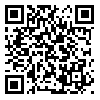Volume 4, Issue 4 (December 2022)
IEEPJ 2022, 4(4): 32-41 |
Back to browse issues page
1- PhD Student in Educational Psychology, Science and Research Branch, Islamic Azad University, Tehran, Iran
2- Associate Professor, Roudehen Branch, Islamic Azad University, Roudehen, Iran , Abbasycol760@gmail.com
3- Professor, Science and Research Branch, Islamic Azad University, Tehran, Iran
2- Associate Professor, Roudehen Branch, Islamic Azad University, Roudehen, Iran , Abbasycol760@gmail.com
3- Professor, Science and Research Branch, Islamic Azad University, Tehran, Iran
Abstract: (1357 Views)
The aim of this study was to determine the frequency and importance of life skills components in social studies textbooks. The research method is content analysis and the units of analysis were sentences and images. The statistical population was all the textbooks of social education in the elementary school in 2021, in which the whole society was considered as a sample. The research tool is a researcher-made checklist and data was analyzed via MAXQDA software. After determining the frequency of indicators, for the comparing the frequencies, Chi-square and Shannon's Entropy method was used. The results revealed that the highest frequency of the life skills components observed in the sixth grade with 1048 cases, the second rank belongs to the fifth grade with 908 cases, and the last rank belongs to the fourth grade with 401 items. The results of chi-square test confirmed the significant differences in frequencies. Also, the results of Shannon's Entropy analysis indicated that the highest coefficient of importance is related to the component of creative thinking and the lowest is related to self-awareness. Overall, the findings have useful implications for designing school-based interventions in teaching life skills.
Type of Study: Original |
Subject:
Educational Psychology
Received: 2019/11/3 | Accepted: 2020/02/24 | Published: 2022/12/1
Received: 2019/11/3 | Accepted: 2020/02/24 | Published: 2022/12/1
References
1. Bengtsson, M. (2016). How to plan and perform a qualitative study using content analysis. NursingPlus open, 2, 8-14. [DOI:10.1016/j.npls.2016.01.001]
2. Botvin, G. J., & Griffin, K. W. (2004). Life skills training: Empirical findings and future directions. Journal of primary prevention, 25(2), 211-232. [DOI:10.1023/B:JOPP.0000042391.58573.5b]
3. Defitrika, F., & Mahmudah, F. N. (2021). Development of life skills education :as char:acter building. International Journal of Educational Management and Innovation, 2(1), 116-135. [DOI:10.12928/ijemi.v2i1.3195]
4. Dixon, K., Janks, H., Botha, D., Earle, K., Poo, M., Oldacre, F., . . . Schneider, K.-L. (2018). A critical analysis of CAPS for Life Skills in the Foundation Phase (Grades R-3). Journal of Education (University of KwaZulu-Natal)(71), 6-23. [DOI:10.17159/2520-9868/i71a01]
5. Erdoğan, M., Kostova, Z., & Marcinkowski, T. (2009). Components of environmental literacy in elementary science education curriculum in Bulgaria and Turkey. Eurasia Journal of Mathematics, Science and Technology Education, 5(1), 15-26. [DOI:10.12973/ejmste/75253]
6. Gharbavi, A., & Mousavi, S. A. (2012). A content analysis of textbooks: Investigating gender bias as a social prominence in Iranian high school English textbooks. English Linguistics Research, 1(1), 42-49. [DOI:10.5430/elr.v1n1p42]
7. Grant, J. (2018). Principles of curriculum design. Understanding medical education: Evidence, theory, and practice, 71-88. [DOI:10.1002/9781119373780.ch5]
8. Guo, D., Wright, K. L., & McTigue, E. M. (2018). A content analysis of visuals in elementary school textbooks. The Elementary school journal, 119(2), 244-269. [DOI:10.1086/700266]
9. Hasani, R., & Abdi, D. (2023). The Concept of Media Literacy in Secondary Media Thinking and Literacy Textbooks from the Perspective of Qualitative Content Analysis. Interdisciplinary Studies in Media and Culture, 12(2).
10. Jones, M. I., & Lavallee, D. (2009). Exploring the life skills needs of British adolescent athletes. Psychology of sport and Exercise, 10(1), 159-167. [DOI:10.1016/j.psychsport.2008.06.005]
11. Kurtdede-Fidan, N., & Aydogdu, B. (2018). Life Skills from the Perspectives of Classroom and Science Teachers. International Journal of Progressive Education, 14(1), 32-55. [DOI:10.29329/ijpe.2018.129.4]
12. Mosapour Miyandehi, P., & Mansouri, M. (2022). Content analysis of the textbook of social studies in the elementary school in the academic year 1399-1400 based on the level of attention to the components of national identity. پژوهش در آموزش مطالعات اجتماعی, 4(1), 107-127.
13. Nozari, A. Y., Siamian, H., & Talavaki, M. M. (2016). Content Analysis of Fourth Grade Social Studies Book Considering the Social Skills Aspect. INTERNATIONAL JOURNAL, 3(2).
14. Prajapati, R., Sharma, B., & Sharma, D. (2017). Significance of life skills education. Contemporary Issues in Education Research (CIER), 10(1), 1-6. [DOI:10.19030/cier.v10i1.9875]
15. Samiei, D., & Mehrabi, Z. (2019). Content Analysis of the First Chapter of the Twelfth Grade Chemistry Book Based on the William Romey's Method and Determining Its Importance with the Shannon Entropy Method. Research in Chemistry Education, 1(3), 53-72.
16. Scheerens, J. (1990). School effectiveness research and the development of process indicators of school functioning. School effectiveness and school improvement, 1(1), 61-80. [DOI:10.1080/0924345900010106]
17. Táboas-Pais, M. I., & Rey-Cao, A. (2012). Gender differences in physical education textbooks in Spain: A content analysis of photographs. Sex roles, 67(7), 389-402. [DOI:10.1007/s11199-012-0174-y]
18. Tarr, J. E., Grouws, D. A., Chávez, Ó., & Soria, V. M. (2013). The effects of content organization and curriculum implementation on students' mathematics learning in second-year high school courses. Journal for Research in Mathematics Education, 44(4), 683-729. [DOI:10.5951/jresematheduc.44.4.0683]
19. Wade, R. C. (1993). Content analysis of social studies textbooks: A review of ten years of research. Theory & Research in Social Education, 21(3), 232-256. [DOI:10.1080/00933104.1993.10505703]
| Rights and permissions | |
 |
This work is licensed under a Creative Commons Attribution-NonCommercial 4.0 International License. |






